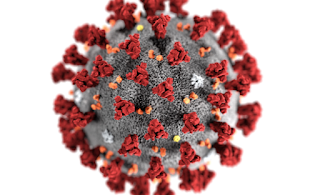How disease plays out in other countries besides China could predict pandemic, says former FDA chief
WASHINGTON -- Never mind China; how the COVID-19 coronavirus outbreak progresses in Singapore is key to understanding the danger to the rest of the world, said Scott Gottlieb, MD, at a Senate committee hearing.
"So far, in Singapore with 50 cases identified... eight are in the ICU. That's deeply concerning to me," said Gottlieb, the former FDA commissioner and now a resident fellow at the American Enterprise Institute, at a Senate Committee on Homeland Security & Governmental Affairs hearing Wednesday.
Of particular importance is how many of those infected with the virus develop severe disease, he said.
Local transmission now appears to be established in Singapore, the densely populated tropical city-nation at the tip of the Malaysian peninsula.
He acknowledged the importance of continuing to watch the epidemic in China. But regardless of what happens there, places such as Singapore, Japan, and Hong Kong, will offer a better idea of how the virus could spread around the world.
The outbreak's advancement in Singapore during a time of warm weather (currently 80°F) is especially alarming, he said, because summer weather would ordinarily be "a backstop" against coronavirus transmission.
Gottlieb -- who has no formal background in public health but participated in biodefense and pandemic preparedness programs at the FDA prior to becoming commissioner -- said that what he's seen so far indicates that the disease may become a pandemic.
While he said that Singapore has done "exquisite reporting" of novel coronavirus cases, "I don't trust the reporting in China," as it has included only the most severe cases, in part because of limited testing capacity. This underreporting could lead to a "skewed view of the case fatality rate." (On Wednesday, case counts in Hubei province, where the outbreak originated and remains the most heavily affected area, began to reflect all cases diagnosed, not just those hospitalized.)
Gottlieb said he is worried that the novel virus could reflect a "sweet spot" between being efficient enough for quick transmission, and virulent enough over a large population "that it causes a lot of death and disease."
Mortality with the novel coronavirus has been put at about 2%, but the denominator in that calculation has been China's case counts that don't include individuals with mild infections. Yet even a "case fatality rate of 0.2 or 0.5 [percent] could be catastrophic if this is highly, highly contagious and spreads around the world," Gottlieb said.
Gottlieb warned that if China were to "take the brakes off" its containment measures -- which he said has been rumored -- the rate at which cases spread could accelerate.
Already he said he suspects there may be cases in Malaysia and parts of Africa that have not yet been identified.
"And what's happening here? There's probably spread that we're just not detecting yet," Gottlieb said. He said current policies on novel coronavirus screening, with their focus on travel to China, are too narrow.
Modeling from the U.K. suggests that for every identified case there are three or four that haven't been identified, he added.
'A very virulent virus'
Julie Gerberding, MD, who headed the CDC in the George W. Bush administration, echoed Gottlieb's concerns, adding that it isn't clear if the most severely ill patients are simply "the tip of the iceberg ... So, we could be having much more transmission, but those people aren't being tested."
"On the other hand, this does appear to be a very virulent virus with a fatality rate that's higher than what we've seen with seasonal influenza. Given that situation, we have to be concerned that even if most people aren't very ill, there is going to be a significant impact on the overall population," she told senators.
Gerberding warned that it may not be possible to contain the novel virus, but there should be a strong focus on slowing viral spread, by making gloves and masks available, employing "social distancing," and leveraging early school closings if necessary. During the 2014-2015 Ebola outbreak in West Africa, she and other public health experts referred to this approach as the "Swiss cheese" model because none of these practices alone could prevent spread, but when layered on each other, could create solid protection.
One significant concern described by panelists was the lack of "surge capacity" in the U.S. healthcare system -- the ability to handle sudden large increases in patient loads -- and the absence of funding to prepare for emergencies.
"Even though we don't know how lethal this virus is, it's pretty clear that it's sufficiently lethal to stress severely the healthcare systems, because of the lack of surge capacity we have to take care of [a] large influx of patients with acute and serious respiratory diseases," Luciana Borio, MD, former director for medical and biodefense preparedness at the National Security Council from 2017 to 2019, told the committee.
Gerberding added that the healthcare system and the government undervalue health promotion and disease prevention: "It's complacency, crisis, complacency."
Gottlieb pointed to the need for a point-of-care diagnostic test as a key tool to catch outbreaks as they develop in this country.
In addition, he warned of the possibility of disruptions in medical supplies in the coming months. Hubei province is a major manufacturing center for pharmaceutical ingredients, including some used in antibiotics production -- and 80% of antibiotics used in the U.S. comes from China, he testified. Medical devices also rely heavily on Chinese components, he said.
Most of the manufacturers he's spoken with have 1 to 3 months or "a little bit more inventory" on hand, Gottlieb told MedPage Today after the hearing.
Gottlieb said it was important to identify "choke points" in the supply chain -- sole-source manufacturers of critical ingredients or components in important products. He suggested that the FDA could require manufacturers to prepare for potential shortages by developing alternative sources.

Comments
Post a Comment